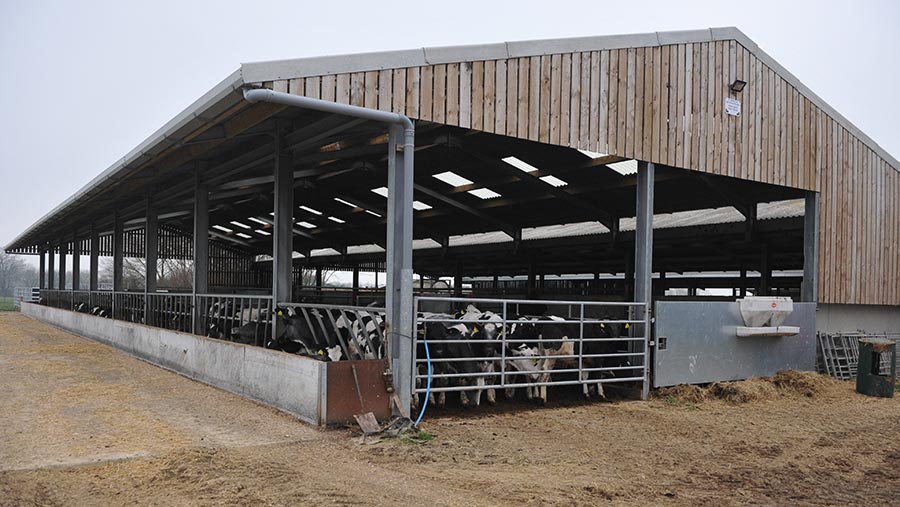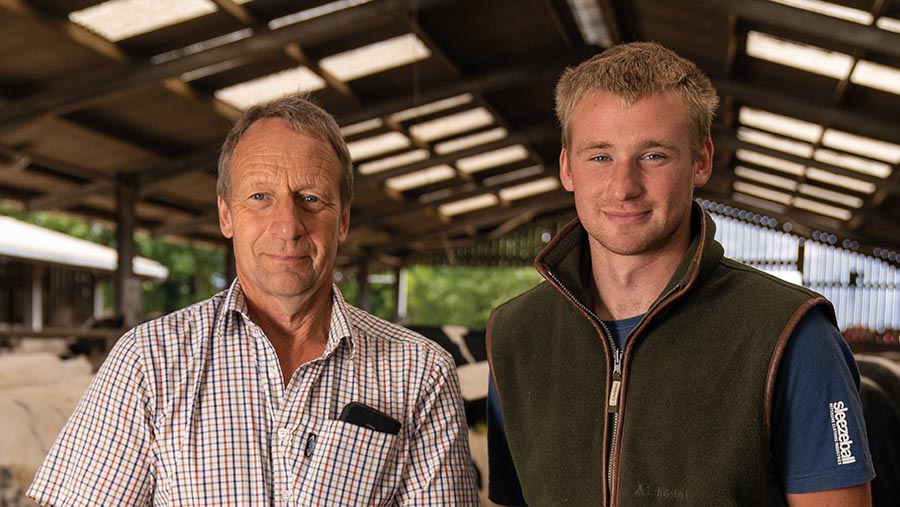How finishing beef adds value to dairy business
 The new calf-rearing shed measures 40x14m © MAG/David Jones
The new calf-rearing shed measures 40x14m © MAG/David Jones The Mallett family decided to invest £100,000 in a shed to rear and finish beef bulls and heifers from their high-yielding dairy herd while they were locked up with TB.
It provided an opportunity to add value to their calves, achieving an average margin of £288 a head.
Two years on, the herd at Northleaze Farm, Highworth, Swindon, is now clear of TB and the beef system is providing a valuable additional income stream for the business.
See also:Farmers Weekly Awards 2020: Dairy Farmer of the Year
“We are pleased we have had beef to balance against a low milk price in the past 12 months. It adds another string to our bow,” says Robert Mallett, 2020 Farmers Weekly Dairy Farmer of the Year.
Farm facts
- 230-cow milking herd
- 140 heifer replacements
- Three-times-a-day milking
- Annual milk sales of 2.6m litres
- Milk sold to Freshways
- Three full-time staff
Robert and his son, David, who oversees the beef unit, share their strategies for finishing at 14 months.
The shed
The beef cattle are fully housed through to finishing. The new nine-bay shed measures 40x14m and was erected to adjoin the existing dairy heifer-rearing accommodation – it is a replica of that building.
There are five pens, each with the capacity to hold up to 25 cattle, but these can be doubled in size to accommodate a larger group.
Although it has been built for finishing beef, the Malletts have designed it with the option to convert it into cubicles, should they one day expand their dairy herd.

Robert Mallett and his son, David © Tom Askew-Miller
“The farm is always going to be primarily dairy. We wanted to make the shed flexible to safeguard our future and give us the option of milking more cows one day,” says Robert.
No concrete flooring was laid in the bedding area – the straw-bedded pens sit on limestone, which is not only good for drainage, but also reduced build costs.
“We would have needed to rip out the concrete if we then decided to put in cubicles… and we knew we could manage without it,” adds Robert.
The shed is open-sided along its length, with Yorkshire boarding part way down the gable ends. A gap between the roofs of the two adjoining sheds allows air to circulate.
Genetics
The Malletts use only sexed Holstein semen to breed replacements. More than half of the replacements are bred from maiden heifers using top profitable lifetime index (PLI) bulls, with an emphasis on lifespan.
British Blue genetics are used on lower-genetic-merit cows owing to the breed’s short gestation length and easy-calving traits.
The British Blue sire chosen scores 0.2% for difficult calvings and has lived up to that promise, says Robert. “We have calved 300 calves by him in the past two years and only needed to assist with four.”
Calf rearing to weaning
Newborn calves are tube-fed 4 litres of colostrum within the first four hours – and ideally the first two. Colostrum is measured with a refractometer, and it must have a minimum Brix value of 25 immunoglobulins (IgG).
After that first colostrum feed, calves receive up to 10 litres/day of transition milk for the first four days, fed twice a day.
Newborn calves are initially housed in a dedicated calf shed and, for ease of management, all the bulls are castrated.
“The ventilation in the new shed is a bit too good for very young calves. It can get exposed in the winter, so we don’t move them across until they are about eight weeks old,” says David.
For the younger calves, straw bales are used to construct “pens within pens” inside a shed to create a barrier from the wind.
A 1ml injection of multi-vitamin is given at birth to prevent nutritional scour. At about £0.40 a head, David says this has been one of the best investments.
“Ella White of Drove Farm Vets was doing a study on vitamin A and suggested we tried this because we were having cases of nutritional scour,” he explains.
There have been no cases since this policy was introduced. The calves then move on to a whey-based 21% protein calf milk replacer (CMR), mixed at 12.5% and fed twice a day at 10 litres a head a day.
Concentrates are offered from one week, but intakes don’t pick up until week four, when CMR is halved to 5 litres. Thereafter, it is gradually reduced until weaning at seven weeks. Concentrate intakes must be at least 1kg a head a day at weaning.
Post-weaning calf rearing
Calves are weaned at seven weeks when they should weigh about 75kg – double their birthweight.
An 18% calf pellet containing the coccidiostat decoquinate is fed ad-lib with bought-in barley straw to aid rumen development.
At three months, animals transition to an 18% grower pellet without the decoquinate. At that point, the cattle are consuming 6-7kg a head daily.
At four months, cattle are vaccinated against clostridial diseases. When they are five months old, their diet is switched to a 50:50 blend comprising grower pellets and urea-treated triticale.
At eight months they are introduced to an ad-lib total mixed ration of wholecrop, maize, triticale and soya.
Of the 40ha (100 acres) of wheat grown, some is wholecropped, with the rest combined and the grain treated with urea.
The Malletts admit they have yet to find the perfect ration, but they have many options to use straights bought in bulk primarily for the dairy herd.
Growth and finishing targets
The finishing target is 600kg liveweight at R4-, killing out at 54%. “We could push them further, to a liveweight of 650kg, but as block-calvers we would be struggling for space to keep them for longer,” David admits.
“The crunch point comes when the next batch is born. We don’t want to compromise the health of the baby calves.”
A new handling system makes monthly weighing a straightforward job, as all animals have electronic tags. The set-up has a circular forcing pen, a 9m-long race, a crush with a head yoke, and a built-in weighing platform.
It cost £18,000, inclusive of the concrete base, with the equipment part-funded by a Countryside Productivity Small Grant.
It takes two people an hour-and-a-half to weigh all 125 cattle. Cattle have averaged 1.4kg daily liveweight gain over their lifetime (431 days). “The steers are growing at 1.6kg at four to five months and the heifers at 1.4kg,” says David.
Most finished cattle are currently marketed deadweight through a dealer to St Merryn or ABP. Others are sold as stores, with a small group sold recently sold online through Breedr.
Enter the 2021 Farmers Weekly Awards
 The 2021 Farmers Weekly Dairy Farmer of the Year Award is sponsored by Virgin Money.
The 2021 Farmers Weekly Dairy Farmer of the Year Award is sponsored by Virgin Money.
Join Farmers Weekly in celebrating the farming industry and recognising the hard work of UK farmers and enter the Awards today.
Alternatively, nominate a deserving individual for an award.
For more information about the 2021 Farmers Weekly Awards, visit the official website.
